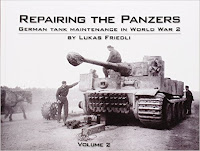
Title: Repairing
the Panzers Vol 1 and 2
Author:
Lukas Friedl
ISBN:
978-0-9841820-5-3
Publisher:
Panzerwrecks
Hardcover
Pages: 256
Photos:
280
 The
strength of these books lies not only with the copious numbers of outstanding
photographs but also with the in-depth narrative surrounding the challenges and
observations of both peace and wartime support. Coming from a small publishing
house, this book is unique in that it focusses exclusively on the maintenance
and logistics aspects of German Panzer operations (which is a refreshing
departure from the hundreds of books focussing on operations and doctrine).
The
strength of these books lies not only with the copious numbers of outstanding
photographs but also with the in-depth narrative surrounding the challenges and
observations of both peace and wartime support. Coming from a small publishing
house, this book is unique in that it focusses exclusively on the maintenance
and logistics aspects of German Panzer operations (which is a refreshing
departure from the hundreds of books focussing on operations and doctrine).
The
photographs are educational in and of themselves both from the visuals and the
brief captions associated with them. The difference between field and garrison
conditions is profound and the use of innovation under field conditions in
order to overcome not only material but also environmental challenges is very
educational. One learns to appreciate the sub-zero environment as opposed to
the desert climate and the unique aspects of each as an example.
Another
aspect of these books, just as relevant and educational, is the narrative that
accompanies the photographs. Drawing upon actual reports and unit histories,
the author draws attention to the shortcomings in various pieces of equipment,
support doctrine, training and development. As an example, the Germans strove
to offset their material shortages by utilizing captured equipment. This,
however, resulted in individual units having hundreds of varieties of equipment
on their inventory thereby exacerbating spares and lubricant issues.
He also
includes extracts from official inspection reports outling issues such as
deficiencies in driver training, poor break-in periods for engines and
components, a lack of oversight in unit/crew maintenance practices and
equipment shortfalls. Additionally, he draws attention via narrative as well as
photography of the challenge of field recovery, especially given the
difficulties of environment and size/weight of the German tanks. The standard
heavy recovery vehicle for the Germans was the SdKfz 9 (18 T half-track
vehicle). Recovery companies were always short of these critical vehicles and
it would take, as an example, three to tow a Tiger and up to 5 to tow a
Ferdinand tank.
The
author is to be commended for providing such a wealth of visual and narrative
information in the form of these very high quality production books. Very
highly recommended for those interested in a more support focussed aspect of
World War 2 operations.
No comments:
Post a Comment